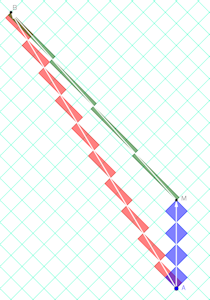If traveling inertially, the clock in the box doesn't know if it's moving.
That's the "Principle of Relativity"!
The following elaborates on Dale's answer.
Geometric analogies are useful.
- On a geometrical plane, a straight-line path from point A to B
(regardless of the direction from A to B)
has a length which is computed by chaining together a sequence of short straight-line segments from A to B.
(This means that the path from A to B doesn't have to be in any particular direction, like vertical or horizontal.)
- In spacetime, an inertial path from event A to B
(regardless of the inertial velocity from A to B as viewed in your frame) has an elapsed-wristwatch-time which is computed by chaining together a sequence of short inertial wristwatch-ticks from A to B.
(This means that the inertial path from A to B doesn't have to be in any particular velocity, like "at rest".)
For piecewise paths...
Triangle inequality: Instead of going a along straight-line-path from A to C, you take (for simplicity) piecewise-straight-line-paths A to M, then M to B. From Euclidean geometry, it turns out that the straight-line-distances satisfy: $$dist(A,M)+dist(M,B) > dist(A,B).$$
"The straight-line path has the shortest distance."
So, the car from A to B will have less tire-wear than the car from A to M to B.
Clock Effect: Instead of going along an inertial-path from A to B, you take (for simplicity) piecewise-inertial-paths A to M, then M to B. From special relativity, it turns out that the inertial-path-elapsed-times satisfy: $$t(A,M)+t(M,B) < t(A,B). $$
"The inertial path logs the longest elapsed-time."
So, the inertial-observer from A to B will have aged more than the non-inertial observer from A to M to B.
Common-Sense Galilean-relativity: Instead of going along an inertial-path from A to B, you take (for simplicity) piecewise-inertial-paths A to M, then M to B. From Galilean relativity, it turns out that the inertial-path-elapsed-times satisfy:
$$t(A,M)+t(M,B) = t(A,B).$$
"The elapsed time logged from A to B is independent of the path from A to B."
So, the inertial-observer from A to B will have aged as much as the non-inertial observer from A to M to B.
Admittedly, it's difficult to visualize the special relativity case because of the non-Euclidean geometry of Minkowski Spacetime. (It is underappreciated that the ordinary position-vs-time graph is also a non-Euclidean geometry... but we've learned to extract information from that diagram.)
To help in "visualizing proper time",
here is a spacetime diagram on rotated graph paper.
The key feature in the construction is that the area of the "light-clock diamonds" (marking off the ticks of a wristwatch)
are equal in magnitude along different inertial worldlines.
The traveller leaves at (3/5)c and returns at (3/5)c
in order to meet up 10-ticks after separation.

When they reunite, the non-inertial traveler (although piecewise-inertial) is younger than the [always] inertial observer.
Although this diagram is drawn from the stay-at-home frame,
the result is independent of the frame of reference.
And there is no Lorentz transformation that will ever straighten out A-M-B to be an inertial path. A ball sitting on a frictionless surface on the traveller's ship will move when the ship necessarily-turns at M. (The analogous situation is true in Galilean relativity.)
(Just like in ordinary geometry... the lengths and angles in a triangle are the same if the figure is rotated. And no rotation will unkink A-M-B to be a straight-line.)



